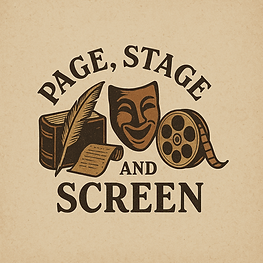The Blair Witch Project: How 90s Culture Shaped This Found Footage Classic
- Kat Collins
- Oct 13
- 4 min read
The late 1990s was a defining period for cinema, especially within the horror genre. One movie that left a lasting mark is The Blair Witch Project. This film wasn't just a horror flick; it was a fresh way to tell a story that resonated deeply with audiences. In this blog post, we will explore how the cultural shifts of the 90s played a significant role in shaping the film's creation and overall success.

The Beginning of Found Footage
Though the idea of found footage existed before, The Blair Witch Project made it mainstream. Filmed in a documentary style, it appealed to a 90s audience eager for authentic experiences. The movie's concept—authentic footage of filmmakers lost in the mysterious woods—aligned perfectly with the era's craving for truth in entertainment. Urban legends were becoming more popular, and with the internet still in its infancy, we turned to documentaries.
Shows like The Real World and Survivor, which debuted in the 90s, blurred the lines between reality and fiction. According to a survey, over 70% of viewers felt drawn to reality TV, indicating a desire for believable stories. The Blair Witch Project embraced this trend and thrived, whether intentionally or not. Its marketing strategy included a well-crafted website that hinted at the story being true, increasing audience intrigue. A marketing strategy that can never be duplicated.
The Internet and Viral Marketing
1999 marked a shift in how media was consumed, thanks to the early internet. The Blair Witch Project was one of the first films to employ viral marketing effectively. The filmmakers launched a website filled with fake news articles, missing person reports, and even a mock documentary about the Blair Witch legend. This innovative tactic helped generate significant buzz, leading to a box office take of nearly $250 million against a budget of just $60,000, estimated.
This marketing campaign resonated with the accessible information of 90s culture. As more people began to trust online sources, the film's online presence allowed fans to engage with the narrative. Communities sprang up, with fans sharing theories and experiences, making the film’s world feel all the more real and immersive.
The Influence of 90s Horror
The horror scene in the 90s was exciting and diverse, leaning heavily on both slasher films and psychological thrillers. Movies like Scream and The Sixth Sense recreated the genre's rules by focusing on intelligent storytelling and character depth. In this evolving landscape, The Blair Witch Project introduced a new form of horror—one that thrived on atmosphere and the unknown.
With its minimalistic approach, the film strategically avoided graphic violence. Instead, it emphasized suggestion and fear of the unseen. This shift reflected a broader cultural yearning for narratives that lingered with audiences. In fact, studies showed that movies emphasizing psychological fear had a more profound impact, with 80% of viewers finding them scarier than those full of gore.
The Power of Myth and Urban Legends

During the 90s, the public interest in urban legends surged, buoyed by the internet's capacity to spread stories quickly. The Blair Witch Project cleverly harnessed this fascination by crafting a narrative that mirrored the feel of an urban legend. Its lore, which revolved around the mysterious Blair Witch and the vanished filmmakers, tapped into the collective imagination.
This connection made the film more relatable and strikingly believable. People are naturally drawn to impactful stories tied to folklore. When viewers encounter a narrative that evokes a sense of real-life danger, it amplifies their fear. Anecdotal evidence indicates that people frequently shared personal stories after viewing the film, highlighting its immersive quality.
The Cultural Impact of the Film
The Blair Witch Project transcended typical filmmaking. Its remarkable success demonstrated that innovative storytelling could attract significant attention, earning it a spot as a cultural phenomenon. Beyond the box office numbers, its influence reached far and wide, inspiring many filmmakers.
The found footage style, now widely used, has appeared in numerous films from Paranormal Activity to Cloverfield. The way filmmakers tackle storytelling today often reflects the film's legacy, emphasizing realism and emotional engagement. The ripple effects of this movie continue to shape the horror genre.
Reflections on a Landmark Film
The Blair Witch Project encapsulates the cultural dynamics of the 90s. Its unique use of found footage, inventive marketing, and ties to urban legends created a film that not only scared audiences but also shifted the horror genre's direction. As we revisit this classic, we recognize that its success was not merely a coincidence; it was a reflection of a society ready for innovative storytelling.
In our current landscape, where authenticity and viewer engagement are more crucial than ever, The Blair Witch Project stands as a testament to creativity's power and the significant impact of cultural context on art. Whether someone is a dedicated horror fan or just a casual viewer, this film is a compelling example of how the 90s influenced not just one movie but an entire genre.
Having been there myself—I watched it in the theater, followed the updates on the website, and discussed it at school—the brilliance of this film still astounds me. At the time, we all thought it was real. The movie is entirely improvised by its three main actors, and combined with the situational experiences and marketing, it truly was a perfect storm. Heather Donahue, Joshua Leonard, and Michael C. Williams all delivered outstanding performances. I've had the chance to watch Michael's TikToks and his first TikTok Live where he did a Q&A. The insights he shares about the making of this film are incredible, and I highly recommend following him.
Have you seen this film? Were you able to experience it as it was happening? Sound off in the comments below!






Comments